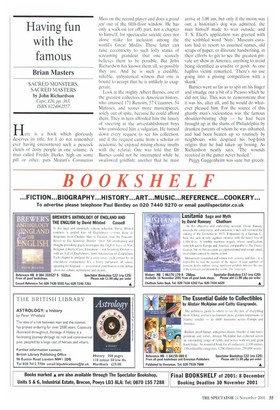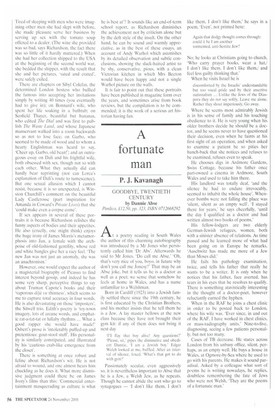Having fun with the famous
Brian Masters
SACRED MONSTERS, SACRED MASTERS by John Richardson Cape, £20, pp. 363, ISBN 0224062557 Here is a book which gloriously deserves its title, for I do not remember ever having encountered such a peacock clutch of dotty people in one volume. A man called Freddy Herko, high on some pill or other, puts Mozart's Coronation
Mass on the record player and does a grand fete out of the fifth-floor window. He has only a walk-on (or off) part, not a chapter to himself, for spectacular suicide does not alone make for inclusion among the world's Great Misfits. These latter can raise eccentricity to such lofty status of screaming grandeur that one scarcely believes them to be possible. But John Richardson has known them all, so possibly they are. And he is such a credible, unhysterical witness that one is bound to accept that he is unlikely to exaggerate.
Look at the mighty Albert Barnes, one of the greatest collectors in American history, who amassed 171 Renoirs, 57 Cezannes, 54 Matisses, and scores more masterpieces, solely out of spite, because he could afford them. They in turn afforded him the luxury of sneering at the art-establishment boys who considered him a vulgarian. He turned down every request to see his collection, and if the request came from a scholar or academic, he enjoyed mixing choice insults with the refusal. One was told that Dr Barnes could not be interrupted while he swallowed goldfish; another that he must
arrive at 3.00 am, but only if the moon was out; a historian's dog was admitted, the man himself made to wait outside; and T. S. Fliot's application was greeted with the scribbled word 'Nuts'. Museum curators had to resort to assumed names, old scraps of paper, or illiterate handwriting, in their efforts to get to see the greatest private art show in America, anything to avoid being identified as erudite or posh. As one hapless victim remarked, 'There's no use going into a pissing competition with a skunk.'
Barnes went so far as to spit on his finger and smudge out a bit of a Picasso which he did not like. This was to demonstrate that it was his, after all, and he would do whatever pleased him. For the source of this ghastly man's viciousness was the famous shoulder-bearing chip — he had been brought up in the slums of Philadelphia by drunken parents of whom he was ashamed, and had been beaten up so routinely by neighbours who despised his bog-Irish origins that he had taken up boxing. As Richardson neatly says, 'The wounds received in the gutter never healed.'
Peggy Guggenheim was sane but greedy. Tired of sleeping with men who were imagining other men she had slept with before, she made pleasure serve her business by serving up sex with the tomato soup offered to a dealer. (The wine she provided was so bad, says Richardson, the fact there was so little of it hardly mattered.) When she had her collection shipped to the USA at the beginning of the second world war, she bedded the shipper, with the result that she and her pictures, 'sated and crated', were safely exiled.
There are chapters on Sibyl Colefax, the determined London hostess who bullied the famous into accepting her invitations simply by writing 40 times (you eventually had to give in); on Bonnard's wife, who spent her life soaking in a bathtub; on Scofield Thayer, beautiful but bananas, who edited The Dial and was first to publish The Waste Land, and whose Japanese manservant walked into a room backwards so as not to lose face: on Garbo, who seemed to be made of wood and to whom a hearty Englishman was heard to say, 'Cheer up, Garbo, old bean!'; and an outrageous essay on Dali and his frightful wife, both obsessed with sex, though not so with each other. What they actually did can hardly bear reprinting (nor can Lorca's explanation of Dali's route to tumescence). But one sexual allusion which I cannot resist, because it is so unexpected, is Winston Churchill's comment on the beautiful Lady Castlerosse (part inspiration for Amanda in Coward's Private Lives) that she 'could make even a corpse come'.
If sex appears in several of these portraits it is because Richardson relishes the funny aspects of bodies and their appetites. He also (cruelly, one might think) enjoys the huge irony of James Morris's metamorphosis into Jan. a female with the archpoise of old-fashioned gentility, whose red and white bangles give her a racy feel. 'The new Jan was not just an anomaly, she was an anachronism.'
However, one would expect the author of a magisterial biography of Picasso to find interest beyond gossip, and indeed he has some very sharp, perceptive things to say about Truman Capote's books and their 'vaporous defa vu thinness', which seems to me to capture total accuracy in four words. He is also devastating on those 'imposters', the Sitwell trio. Edith's poetry is 'toy-town imagery, lots of arcane words, and emphatic rat-a-tat-tat or lullaby rhythms ... What a good rapper she would have made!' Osbert's prose is 'intolerably puffed-up and pretentious: gout-stool stuff'. His personality is similarly constipated, and illustrated by his 'cautious crab-like emergence from the closet'.
There is something at once robust and feline about Richardson's wit. He is not afraid to wound, and one almost hears him chuckling as he does it. What more dismissive judgment could there be on James Ivory's films than this: 'Commercial entertainment masquerading as culture is what he is best at'? It sounds like an end-of-term school report, as Richardson diminishes the achievement not by criticism alone but by the deft style of the insult. On the other hand, he can be sound and warmly appreciative, as in the best of these essays, an account of Andy Warhol which astonishes by its detailed observation and subtle conclusions, showing the slack-haired artist to be shy, conservative, pious, with a clean Victorian kitchen in which Mrs Becton would have been happy and not a single Warhol picture on the walls.
It is fair to point out that these portraits have been published in magazine form over the years, and sometimes arise from book reviews, but the compilation is to be commended: it is the work of a serious art historian having fun.



















































































 Previous page
Previous page